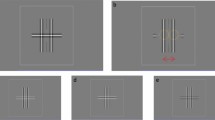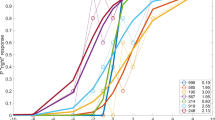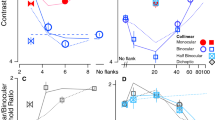Abstract
THIS communication describes experiments in which the threshold contrast of gratings viewed monocularly and binocularly have been determined (Fig. 1). We have modified the technique of Schade1 so that a grating target is generated on an oscilloscope by supplying suitable signals to the x, y and z axes. It could be continuously varied both in contrast and fineness (spatial frequency) without the mean luminance of the screen changing. The energy distribution across the grating varied sinuosoidally. The grating filled a rectangular area subtending 2° by 1.3°, and was surrounded by a circular field of 12° diameter of the same luminance as the oscilloscope screen (80 cd/m2). The screen was viewed from 57 in., and in all the experiments particular care was taken to correct the eye to within 0.12 diopter with spectacle lenses.
This is a preview of subscription content, access via your institution
Access options
Subscribe to this journal
Receive 51 print issues and online access
$199.00 per year
only $3.90 per issue
Buy this article
- Purchase on Springer Link
- Instant access to full article PDF
Prices may be subject to local taxes which are calculated during checkout
Similar content being viewed by others
References
Schade, O. H., J. Opt. Soc. Amer., 46, 721 (1956).
Campbell, F. W., Robson, J. G., and Westheimer, G., J. Physiol., 145, 575 (1959).
Stiles, W. S., and Crawford, B. H., Proc. Roy. Soc., B, 112, 428 (1933).
Campbell, F. W., J. Physiol., 144, 25P (1958).
Barany, E., Acta Ophthal. Kbh., 24, 63 (1946).
Horowitz, M. W., J. Exp. Psychol., 39, 581 (1949).
Lythgoe, R. J., and Phillips, L. R., J. Physiol., 91, 427 (1937–38).
Crozier, W. J., and Holway, A. H., J. Gen. Physiol., 22, 341 (1939).
Pirenne, M. H., Nature, 152, 698 (1943).
Hubel, D. H., and Wiesel, T. N., J. Physiol., 160, 106 (1962).
Barlow, H. B., J. Opt. Soc. Amer., 46, 634 (1956).
Barlow, H. B., J. Physiol., 141, 337 (1958).
Schlaer, S., J. Gen. Physiol., 21, 165 (1937).
Author information
Authors and Affiliations
Rights and permissions
About this article
Cite this article
CAMPBELL, F., GREEN, D. Monocular versus Binocular Visual Acuity. Nature 208, 191–192 (1965). https://doi.org/10.1038/208191a0
Issue Date:
DOI: https://doi.org/10.1038/208191a0
This article is cited by
-
Altering chromatic aberration: how this latest trend in intraocular-lens design affects visual quality in pseudophakic patients
Eye and Vision (2023)
-
Binocular summation of visual acuity and contrast sensitivity in children with intermittent exotropia
BMC Ophthalmology (2023)
-
Space, time, and dynamics of binocular interactions
Scientific Reports (2023)
-
Pupil size effect on binocular summation for visual acuity and light disturbance
International Ophthalmology (2022)
-
Improvement of binocular summation in intermittent exotropia following successful postoperative alignment
Scientific Reports (2021)
Comments
By submitting a comment you agree to abide by our Terms and Community Guidelines. If you find something abusive or that does not comply with our terms or guidelines please flag it as inappropriate.



